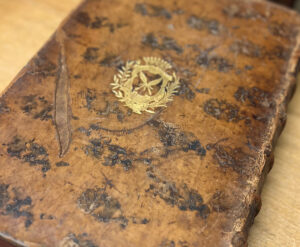
By Emma Laws, Cathedral Librarian
This is a Cat’s Paw binding – so-called because it looks like a cat has stepped in black paint and walked across the binding. It’s not an entirely unlikely scenario; about ten years ago, a PhD student researching manuscripts in the Dubrovnik State Archives came across a medieval manuscript which really had been walked across by a cat with inky paws. I’m told not much has changed – except these days its keyboards, not manuscripts.
Of course, no cats were involved in the making of this binding. The binder created the mottled pattern by applying a stain containing acid; other decoration might include fillets (lines), coats of arms and ornaments, often tooled in gold. Some Cat’s Paw bindings are delicate and regular – this pattern is rather heavy and haphazard and, if you look closely, you can see where over time the acid in the stain has bitten into the surface of the leather a little too deeply. And someone, or something, appears to have had a go at it with a sharp implement – perhaps a cat’s claw!
Cat’s Paw bindings were popular in the second half of the 18th century. They are typically found on books bound in calfskin which is easily manipulated, and can be polished to give a smooth, shiny finish. The various stages of binding a book were divided into two broad areas: folding and sewing paper to make pages and attaching boards and covering them in leather, vellum, cloth, etc., was called ‘forwarding’ while decorating the outside of a book was called ‘finishing’. In the 18th century, these processes were still done by hand so no two bindings are the same.